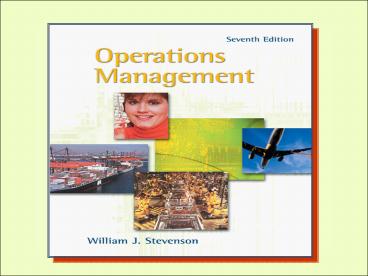PRODUCTIONS/OPERATIONS MANAGEMENT - PowerPoint PPT Presentation
Title:
PRODUCTIONS/OPERATIONS MANAGEMENT
Description:
Chapter One Introduction to Operations Management Operations Management includes: Forecasting Capacity planning Scheduling Managing inventories Assuring quality ... – PowerPoint PPT presentation
Number of Views:151
Avg rating:3.0/5.0
Title: PRODUCTIONS/OPERATIONS MANAGEMENT
1
(No Transcript)
2
PART ONE
INTRODUCTION
- Chapter One
- Introduction to Operations Management
- Chapter Two
- Competitiveness, Strategy, and Productivity
3
Chapter One
- Introduction to Operations Management
4
Operations Management
Introduction to Operations Management
5
Introduction to Operations Management
- Operations Management includes
- Forecasting
- Capacity planning
- Scheduling
- Managing inventories
- Assuring quality
- Motivating employees
- And more . . .
6
Introduction to Operations Management
Business Operations Overlap
7
Introduction to Operations Management
Goods-service continuum
8
Introduction to Operations Management
Stage of Production Value Added Value of Product
Farmer produces and harvests wheat 0.15 0.15
Wheat transported to mill 0.08 0.23
Mill produces flour 0.15 0.38
Flour transported to baker 0.08 0.46
Baker produces bread 0.54 1.00
Bread transported to grocery store 0.08 1.08
Grocery store displays and sells bread 0.21 1.29
Total Value-Added 1.29
9
Introduction to Operations Management
Types of Operations
Operations
Examples
10
Introduction to Operations Management
Value-Added
The difference between the cost of inputs and
the value or price of outputs.
11
Introduction to Operations Management
Food Processor
12
Introduction to Operations Management
Hospital Process
13
Introduction to Operations Management
Operations Interfaces
14
Introduction to Operations Management
Decision Making
15
Introduction to Operations Management
Decision Making
16
Introduction to Operations Management
Major Characteristics of Production Systems
Degree of standardization
Type of operation
project
job shop
repetitive production
continuous processing
17
Introduction to Operations Management
Manufacturing or Service?
18
Introduction to Operations Management
Key Differences
These differences are beginning to fade
in many cases
19
Introduction to Operations Management
Manufacturing vs Service
20
Introduction to Operations Management
Responsibilities of Operations Management
21
Introduction to Operations Management
Models
A model is an abstraction of reality.
Tradeoffs
What are the pros and cons of models?
22
Introduction to Operations Management
Systems Approach
The whole is greater than the sum of the parts.
23
Introduction to Operations Management
Quantitative Approaches
24
Introduction to Operations Management
Pareto Phenomenon
A vital few things are important for reaching
an objective or solving a problem.
80/20 Rule - 80 of problems are caused by
20 of the activities.
How do we identify the vital few?
25
Introduction to Operations Management
Recent Trends
- The Internet
- E-Business
- Supply Chain Management
26
Introduction to Operations Management
Simple Product Supply Chain
27
Introduction to Operations Management
Continuing Trends
28
Chapter 2
- Competitiveness, Strategy, and
- Productivity
29
Competitiveness How effectively an organization
meets the needs of customers relative to others
that offer similar goods or services
30
Competitiveness
31
Mission/Strategy/Tactics
How does mission, strategies and tactics relate
to decision making and distinctive competencies?
32
Strategy
- Mission
- The reason for existence for an organization
- Mission Statement
- A clear statement of purpose
- Strategy
- A plan for achieving organizational goals
- Tactics
- The actions taken to accomplish strategies
33
Strategy Example
Example 1
- Rita is a high school student. She would like to
have a career in business, have a good job, and
earn enough income to live comfortably - Mission Live a good life
- Goal Successful career, good income
- Strategy Obtain a college education
- Tactics Select a college and a major
- Operations Register, buy books, take
courses, study,
graduate, get job
34
Planning and Decision Making
35
Strategy Formulation
- Distinctive Competencies
- The special attributes or abilities that give an
organization a competitive edge. - Environmental Scanning
- The considering of events and trends that present
threats or opportunities for a company.
36
Examples of Distinctive Competencies
37
Key External Factors
- Economic conditions
- Political conditions
- Legal environment
- Technology
- Competition
- Markets
38
Key Internal Factors
- Human Resources
- Facilities and equipment
- Financial resources
- Customers
- Products and services
- Technology
- Suppliers
39
New Strategies
- Quality-based strategies
- Focuses on maintaining or improving the quality
of an organizations products or services - Quality at the source
- Time-based strategies
- Focuses on reduction of time needed to accomplish
tasks
40
Time-based Strategies
41
Production
- Craft Production - Highly skilled workers use
simple flexible tools to produce small quantities
of customized goods. - Mass Production - Lower-skilled workers use
specialized machinery high volumes of
standardized goods. - Lean Production - Uses minimal amounts of
resources high volume of high-quality goods.
42
Productivity
- Partial measures
- output/(single input)
- Multi-factor measures
- output/(multiple inputs)
- Total measure
- output/(total inputs)
43
Productivity Growth
44
Measures of Productivity
Table 2-4
45
Examples of Partial Productivity Measures
Table 2-5
46
Example
47
Example--Labor Productivity
- 10,000 units/500hrs 20 units/hour or we can
arrive at a unitless figure - (10,000 unit 10/unit)/(500hrs 9/hr)
22.22 - Can you think of any advantages or disadvantages
of each approach?
48
Example--Multifactor Productivity
MFP Output Labor Materials
MFP (10,000 units)(10) (500)(9)
(5000) (25000)
MFP 2.90
49
Figure 2-2
50
Factors Affecting Productivity
51
Factors Affecting Productivity
- Standardization
- Use of Internet
- Computer viruses
- Searching for lost or misplaced items
- Scrap rates
- New workers
- Cuts in health benefits
52
Factors Affecting Productivity
- Safety
- Shortage of IT workers
- Layoffs
- Labor turnover
- Design of the workspace
- Incentive plans that reward productivity
53
Improving Productivity
- Develop productivity measures
- Determine critical (bottleneck) operations
- Develop methods for productivity improvements
- Establish reasonable goals
- Get management support
- Measure and publicize improvements
- Dont confuse productivity with efficiency
54
Bottleneck Operation
Figure 2-3































